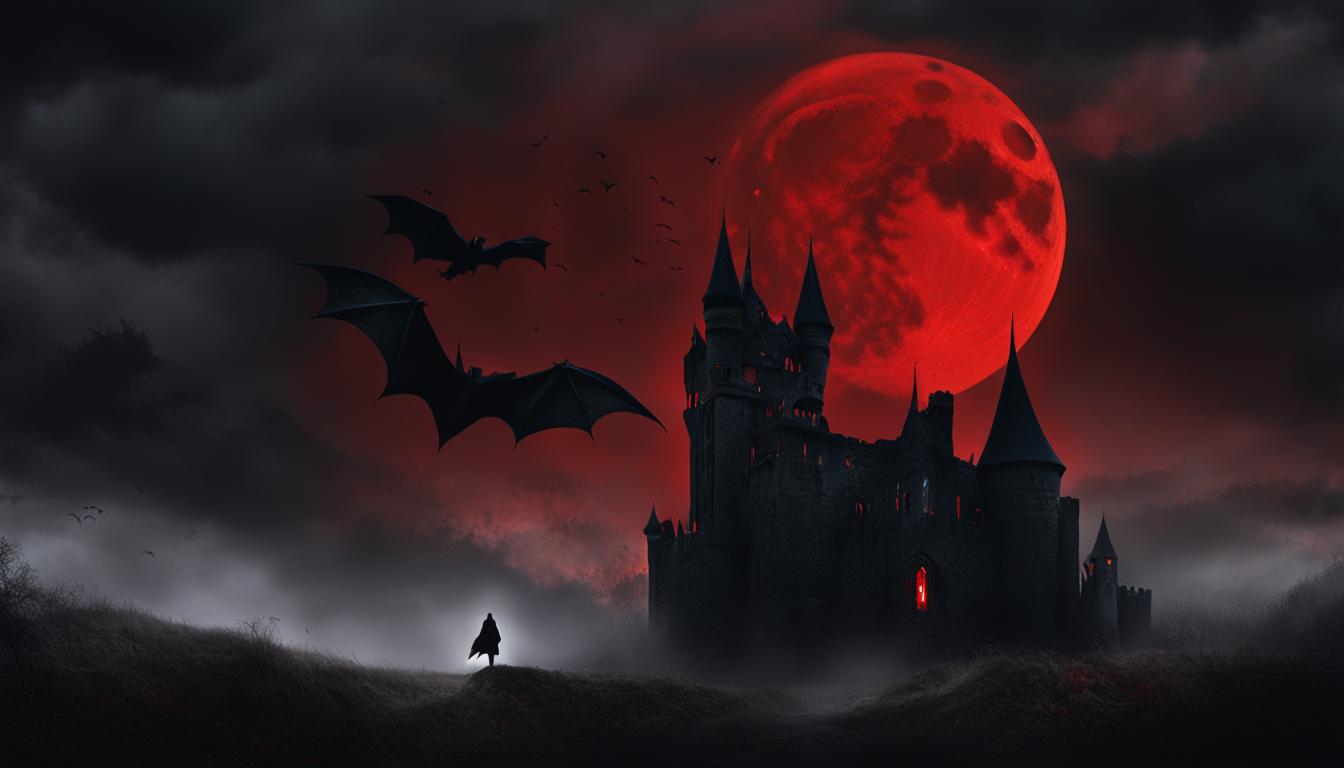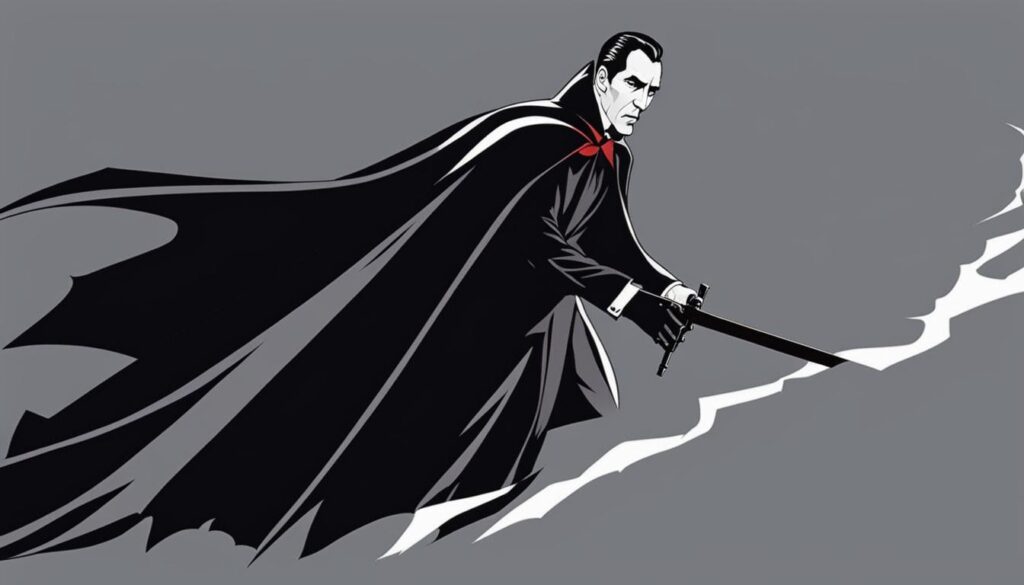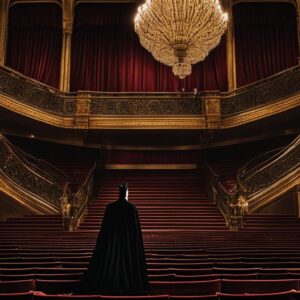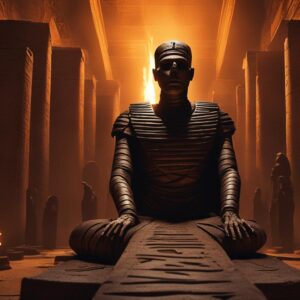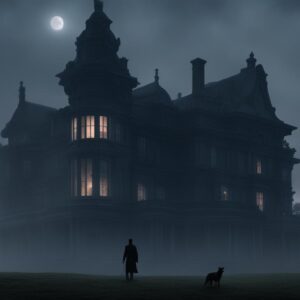As a fan of horror movies, I have always been captivated by the enduring appeal of vampire films. One film that stands out among the classics is “The Horror of Dracula” (1958), a gothic horror masterpiece that has left an indelible mark on the genre. Directed by Terence Fisher and based on Bram Stoker’s novel, this British horror movie is a must-watch for any fan of cult cinema.
Starring Christopher Lee as the iconic Count Dracula and Peter Cushing as Dr. Van Helsing, “The Horror of Dracula” is a thrilling adaptation that successfully combines the elements of gothic horror with the creative vision of Hammer Films. With its atmospheric visuals, unforgettable performances, and impactful storytelling, this film has solidified its place as a classic vampire film and an essential part of the British horror movie legacy.
Key Takeaways:
- “The Horror of Dracula” (1958) is a gothic horror film that has become a cult classic in the horror genre.
- Starring Christopher Lee as Count Dracula and Peter Cushing as Dr. Van Helsing, the film features standout performances that have defined their careers.
- The movie deviates from Bram Stoker’s novel, but its unique twist on the story adds depth and intrigue.
- “The Horror of Dracula” played a significant role in establishing Hammer Films as a prominent name in horror cinema.
- The film’s enduring popularity and cultural impact have made it a timeless masterpiece in the realm of horror movies.
The Cast and Crew Behind the Chills
When it comes to creating a truly memorable horror film, the cast and crew behind the scenes play an integral role. In the case of “The Horror of Dracula” (1958), director Terence Fisher and screenwriter Jimmy Sangster joined forces to bring Bram Stoker’s iconic novel to life on the silver screen. Their vision, combined with the exceptional performances of Christopher Lee and Peter Cushing, elevated the film to cult status in the realm of horror cinema.
Christopher Lee’s portrayal of Count Dracula in “The Horror of Dracula” is nothing short of mesmerizing. Lee’s tall stature, piercing gaze, and commanding presence make him the perfect fit for the iconic vampire. His performance brings a sense of dark seduction and danger to the character, ensuring that audiences are simultaneously drawn to and repelled by his chilling presence.
Peter Cushing’s portrayal of Dr. Van Helsing, the legendary vampire hunter, is equally vital to the success of the film. Cushing’s portrayal is characterized by his intense focus and unwavering determination to rid the world of evil. His chemistry with Lee’s Dracula creates a captivating dynamic, as the two iconic actors clash in an epic battle between good and evil.
Aside from the exceptional performances, the film’s director, Terence Fisher, deserves credit for his masterful direction. Fisher’s expertise in crafting atmospheric and visually striking scenes adds depth and suspense to the film. The gothic sets, eerie lighting, and haunting musical score all contribute to the overall chilling atmosphere of “The Horror of Dracula.”
In summary, the success of “The Horror of Dracula” can be attributed to the talented cast and crew who brought the film to life. Christopher Lee’s portrayal of Count Dracula and Peter Cushing’s performance as Dr. Van Helsing are iconic and continue to be celebrated to this day. Director Terence Fisher’s vision and attention to detail ensured that the film became a classic in the realm of horror cinema.
A Unique Twist on Bram Stoker’s Classic
In “The Horror of Dracula,” director Terence Fisher takes a unique approach to Bram Stoker’s classic novel, deviating from the source material to create a fresh and enthralling adaptation. While the film stays true to the core elements of the story, Fisher introduces creative liberties that add a new layer of intrigue and suspense. One notable departure is the swapping of Lucy and Mina’s roles, offering a fresh dynamic between the characters and altering the narrative arc.
Another significant difference in Fisher’s adaptation is the elevation of Dr. Van Helsing’s role. In Stoker’s novel, Van Helsing serves as a supporting character, providing guidance and expertise to the protagonists. However, in “The Horror of Dracula,” Van Helsing takes center stage as the central protagonist and driving force behind the battle against Count Dracula. This shift not only highlights the character’s intellect and determination but also adds a compelling layer of complexity to the story.
By infusing the narrative with these unique twists, Fisher breathes new life into Bram Stoker’s timeless tale, creating a captivating and distinctive adaptation that stands out among the many versions of Dracula’s story. Through these creative choices, “The Horror of Dracula” remains a standout film in the vampire genre, offering audiences a fresh and thrilling take on a classic tale.
Bringing Vampires to Life with Hammer Horror
“The Horror of Dracula” is a pivotal film in the Hammer Horror genre, which originated in Britain during the 1950s and 1960s. Hammer Films quickly became known for their innovative and often gory approach to horror, and “The Horror of Dracula” is no exception. The film introduced a new, more erotic and violent portrayal of Count Dracula, which left a lasting impact on the vampire genre.
The visual style of “The Horror of Dracula” contributes to the overall chilling atmosphere of the film. The gothic sets, eerie lighting, and haunting musical score create a sense of dread and suspense. The film’s attention to atmospheric details further immerses the audience in the world of Dracula and adds to the horror experience.
“The Horror of Dracula” is a landmark film in the horror genre, with its iconic portrayals of Dracula and Van Helsing setting the standard for future vampire movies. The film’s gothic atmosphere, unforgettable performances, and cultural impact have secured its status as a horror classic. Its enduring popularity is a testament to the enduring appeal of vampires and the timeless quality of well-crafted horror films.
Table:
| Film | Year | Director |
|---|---|---|
| The Curse of Frankenstein | 1957 | Terence Fisher |
| The Mummy | 1959 | Terence Fisher |
| The Brides of Dracula | 1960 | Terence Fisher |
| Taste of Fear | 1961 | Seth Holt |
The Horror of Dracula: Christopher Lee’s Iconic Portrayal of Dracula
When it comes to portraying the iconic vampire Count Dracula, one performance stands above the rest – Christopher Lee’s portrayal in the 1958 British horror film “The Horror of Dracula.” Lee’s portrayal of Dracula in this cult horror cinema classic has become synonymous with the character itself, solidifying his status as one of the most memorable actors to take on the role.
Lee’s performance brought a dark, brooding sexuality to the character, adding a new layer of complexity and appeal. The intensity in his eyes and the way he commanded the screen with his presence made him truly captivating as Dracula. His portrayal of the vampire Count set a new standard for future depictions of the character, influencing countless adaptations and cementing his place in the annals of horror movie history.
Throughout “The Horror of Dracula” and the subsequent Hammer Horror movies, Lee’s portrayal captivated audiences with its blend of seduction, danger, and raw power. His unique interpretation of Dracula showcased the character’s allure and cunning, making him both terrifying and fascinating to watch. Lee’s portrayal of Dracula became an archetype for the vampire genre, leaving a lasting impact on British horror movies and cult horror cinema as a whole.
Table: Christopher Lee’s Dracula Filmography
| Film | Year |
|---|---|
| The Horror of Dracula | 1958 |
| Dracula: Prince of Darkness | 1966 |
| Taste the Blood of Dracula | 1970 |
| Scars of Dracula | 1970 |
Christopher Lee’s portrayal of Dracula in “The Horror of Dracula” and the subsequent films in the series remains a testament to his immense talent as an actor. His interpretation of the character has become an enduring part of horror movie culture, immortalizing him as one of the most iconic figures in the genre.
The Legendary Vampire Hunter: Peter Cushing as Van Helsing
One of the most memorable aspects of “The Horror of Dracula” (1958) is undoubtedly Peter Cushing’s iconic portrayal of Dr. Van Helsing. Cushing brought a sense of authority, intelligence, and determination to the character, making him the perfect foil to Christopher Lee’s seductive and dangerous Count Dracula.
Van Helsing’s role as the legendary vampire hunter is elevated in this adaptation, positioning him as the central protagonist and giving him more agency in the battle against evil. Cushing’s performance showcases his versatility as an actor, as he effortlessly transitions between the character’s rationality and his fierce determination to rid the world of the vampiric menace.
With his distinctive voice, commanding presence, and undeniable chemistry with Christopher Lee, Cushing solidifies his status as a horror icon in “The Horror of Dracula.” His performance, along with his extensive career in the genre, has made him synonymous with the character of Van Helsing and an integral part of the film’s enduring legacy.
Van Helsing and the Battle Against Evil
“Van Helsing himself, Peter Cushing, caught the essence of the character – the obsessive nature of his pursuit, his relentless desire to defeat the vampire and preserve humanity. His Van Helsing had purpose, knowledge, and a steely determination that made him believable as the ultimate vampire hunter.” – Horror Movie Gazette
Cushing’s portrayal of Van Helsing adds depth and complexity to the character, transcending the typical vampire hunter archetype. His unwavering commitment to his mission, combined with his vast knowledge of the supernatural, creates a sense of trust and admiration from the audience. Van Helsing becomes more than a mere adversary to Dracula; he becomes a symbol of hope and the embodiment of good in the face of unspeakable evil.
Throughout “The Horror of Dracula,” Cushing’s Van Helsing navigates the treacherous world of the undead with unwavering resolve, providing a stark contrast to Dracula’s seductive allure. His intellectual prowess and unwavering courage make him a formidable opponent, while his compassion and concern for the innocent serve as a reminder of the values he fights to protect.
As audiences continue to revisit “The Horror of Dracula,” Peter Cushing’s portrayal of Van Helsing remains a standout performance in the realm of horror cinema. His legendary status as the vampire hunter par excellence continues to captivate and inspire horror fans around the world.
The Chilling Atmosphere of Gothic Horror
When discussing “The Horror of Dracula” (1958), it is impossible to overlook the film’s chilling atmosphere of gothic horror. From the moment the opening scene unfolds, the audience is transported into a world surrounded by darkness and mystery. The gothic sets, with their elaborate details and eerie architecture, serve as the perfect backdrop for the terrifying events that unfold throughout the film. From the foreboding castle of Count Dracula to the hauntingly beautiful landscapes, every scene is meticulously crafted to create a sense of dread and unease.
The use of lighting further enhances the film’s atmospheric quality. The filmmakers masterfully manipulate shadows and contrasts, creating a visual language that heightens the tension and adds to the overall sense of foreboding. Whether it’s the shadows cast by candlelight or the piercing brightness of Van Helsing’s lantern, the play of light and darkness contributes to the ominous ambiance that permeates the entire film.
The gothic sets, eerie lighting, and haunting musical score create a sense of dread and suspense.
Another crucial component in establishing the chilling atmosphere is the haunting musical score. The score, composed by James Bernard, is a masterclass in atmospheric horror music. From the haunting opening credits to the intense climax, the music guides the audience through the film’s most suspenseful moments. The use of recurring motifs and dissonant melodies adds an additional layer of unease, further immersing the viewer in the world of gothic horror.
The combination of gothic sets, atmospheric lighting, and haunting music all contribute to the overall chilling atmosphere of “The Horror of Dracula.” It is these elements that envelop the audience in a world of darkness and terror, heightening the impact of the film’s iconic performances and thrilling narrative.
| Elements of Gothic Horror in “The Horror of Dracula” (1958) |
|---|
| Elaborate gothic sets |
| Atmospheric lighting with shadows and contrasts |
| Haunting musical score |
The Horror of Dracula (1958): Critical Acclaim and Cultural Impact
“The Horror of Dracula” (1958) was met with positive reviews upon its release and has since become a classic vampire film, leaving a lasting impact on British horror and cult cinema. Its critical reception and cultural significance have solidified its place among the horror movie classics, making it a must-watch for enthusiasts of the genre.
This Bram Stoker adaptation from Hammer Horror introduced a new, more erotic and violent portrayal of Count Dracula, challenging the conventions of vampire movies at the time. The film’s success paved the way for numerous sequels and established Hammer Films as a prominent name in horror cinema.
“The Horror of Dracula is a landmark film in the vampire genre and set the standard for future adaptations. Its gothic atmosphere, unforgettable performances, and thrilling storytelling make it a timeless masterpiece of horror cinema.” – Horror Movie Classics
Christopher Lee’s iconic portrayal of Count Dracula and Peter Cushing’s compelling performance as Dr. Van Helsing established them as integral figures in the horror genre. Their dynamic chemistry and memorable characters added depth and sophistication to the film, further contributing to its critical acclaim and cultural impact.
To fully appreciate the enduring popularity of “The Horror of Dracula,” one must recognize its significance in the context of British horror cinema and cult film history. The film’s gothic visuals, chilling atmosphere, and captivating storytelling continue to captivate audiences today, solidifying its place as an essential watch for anyone interested in the genre.
| Key Points | Details |
|---|---|
| Critical Acclaim | “The Horror of Dracula” received positive reviews from critics upon its release, praising its performances, atmospheric visuals, and thrilling storytelling. |
| Cultural Impact | The film’s success and enduring popularity have secured its status as a classic vampire film and a significant milestone in British horror cinema. |
| Iconic Performances | Christopher Lee’s portrayal of Count Dracula and Peter Cushing’s performance as Dr. Van Helsing have become iconic in the horror genre. |
| Gothic Atmosphere | The film’s gothic visuals, eerie lighting, and haunting music create a chilling atmosphere that immerses viewers in the world of Dracula. |
| Legacy | “The Horror of Dracula” has had a significant influence on the vampire genre and continues to captivate new generations of horror fans. |
The Legacy of Hammer Horror Films
Hundreds of British horror films have been produced over the years, but few have left as lasting an impact as “The Horror of Dracula” (1958). This iconic film marked the beginning of the Hammer Horror legacy, which would go on to redefine the genre and capture the imaginations of audiences around the world. Hammer Films, known for their distinct blend of gothic atmosphere, lavish production values, and sensational storytelling, became synonymous with British horror cinema.
With “The Horror of Dracula,” Hammer Films found their winning formula: a dark and seductive portrayal of classic monsters, coupled with a modern sensibility that pushed the boundaries of what was acceptable in horror films of the time. This new approach resonated with audiences and set the stage for a string of successful sequels and spin-offs featuring monsters like Frankenstein, The Mummy, and The Werewolf.
The impact of Hammer Horror films can still be felt today in the world of cinema. Their influence can be seen in the modern reimagining of classic monsters in films such as the “Twilight” series and “Underworld.” The gothic aesthetic and atmospheric storytelling style pioneered by Hammer Films continue to inspire filmmakers and captivate audiences, cementing their legacy as true icons of the horror genre.
| Legacy of Hammer Horror Films | British horror movie | Cult horror cinema |
|---|---|---|
| “The Horror of Dracula” marks the beginning of the Hammer Horror legacy. | Hammer Films became synonymous with British horror cinema. | The gothic aesthetic and atmospheric storytelling style continue to inspire filmmakers and captivate audiences. |
| The film’s success paved the way for a string of successful sequels and spin-offs. | Hammer Films redefined the genre with their dark and seductive portrayal of classic monsters. | The impact of Hammer Horror films can still be seen in modern reimaginings of classic monsters. |
| The legacy of Hammer Horror films can be felt in the modern horror genre. | Hammer Films’ distinctive blend of gothic atmosphere and sensational storytelling left an indelible mark on the genre. | Their influence is seen in films like the “Twilight” series and “Underworld.” |
The Influence of “The Horror of Dracula”
“The Horror of Dracula” has had a significant influence on the vampire genre and horror cinema as a whole. The film’s portrayal of Dracula as a seductive and dangerous figure set a new standard for vampire movies. It inspired numerous adaptations and helped popularize the image of vampires as charismatic and alluring creatures of the night.
One of the key aspects of “The Horror of Dracula” that had a lasting impact is Christopher Lee’s iconic portrayal of Count Dracula. His dark and brooding performance brought a sense of menace and seduction to the role, establishing him as one of the most memorable actors to portray the infamous vampire. Lee’s interpretation of Dracula set the template for future actors taking on the role, influencing the way vampires would be portrayed in film and television for years to come.
The success of “The Horror of Dracula” also played a crucial role in the popularity of Hammer Horror films. The film’s critical and commercial success paved the way for a series of sequels and spin-offs, solidifying the Hammer brand as a powerhouse in the horror genre. The distinctive style and approach of Hammer Horror films, characterized by their gothic atmosphere, lavish sets, and visceral violence, became synonymous with the studio and left a lasting impact on the genre as a whole.
Furthermore, “The Horror of Dracula” contributed to the establishment of the vampire as a cultural icon. The film’s combination of horror and sensuality tapped into deep-seated human desires and fears, resonating with audiences on a primal level. This helped cement vampires as enduring figures in popular culture, influencing subsequent vampire movies, TV shows, and literature.
The Legacy of “The Horror of Dracula”
The legacy of “The Horror of Dracula” extends beyond its influence on the vampire genre and Hammer Horror films. It remains a landmark film in the history of horror cinema, showcasing the power of storytelling, charismatic performances, and atmospheric visuals. Its enduring popularity among horror movie enthusiasts is a testament to its status as a timeless classic and a must-see for anyone interested in the genre.
The Enduring Popularity of Classic Horror
Classic horror movies have a timeless appeal that continues to captivate audiences, even decades after their release. One such film that remains a beloved classic in the genre is “The Horror of Dracula” (1958). This classic vampire film has stood the test of time due to its atmospheric visuals, standout performances, and thrilling storytelling.
With its gothic sets, eerie lighting, and haunting musical score, “The Horror of Dracula” creates a chilling atmosphere that immerses viewers in the world of vampires. The film’s attention to detail and commitment to building suspense make it a memorable and terrifying experience.
However, it is the performances of Christopher Lee and Peter Cushing that truly elevate “The Horror of Dracula” to the status of a horror movie classic. Lee’s portrayal of Count Dracula, with his dark and brooding sexuality, remains iconic to this day. Cushing’s portrayal of Dr. Van Helsing, the vampire hunter, adds a sense of authority and determination to the film. The dynamic chemistry between these two actors creates a compelling clash between good and evil.
The enduring popularity of “The Horror of Dracula” can be attributed to its cultural impact and its ability to resonate with audiences. It has inspired numerous adaptations and has helped shape the image of vampires in popular culture. Whether you’re a die-hard horror fan or new to the genre, “The Horror of Dracula” is a must-watch for anyone interested in the history of horror cinema.
The Terror Unveiled: DVD and Blu-ray Releases for The Horror of Dracula (1958)
As a fan of classic vampire films and cult horror cinema, I am thrilled to announce that “The Horror of Dracula” (1958) is now available on DVD and Blu-ray. This iconic British horror movie, known for its chilling atmosphere and unforgettable performances, has been digitally restored and enhanced, offering fans and horror enthusiasts the opportunity to rediscover the terror it invokes.
With these home video releases, you can now experience the eerie gothic sets, haunting musical score, and visually captivating cinematography of “The Horror of Dracula” in high definition. The restored versions of the film truly bring out the atmospheric details that immerse audiences in the world of Dracula, enhancing the horror experience and making it even more spine-chilling.
But the DVD and Blu-ray releases offer more than just the restored film. They also include a wealth of bonus features that provide further insights into the making of this classic vampire film. Commentary tracks from experts in the field, behind-the-scenes documentaries, and interviews with the cast and crew give a deeper understanding of the film’s production and its enduring legacy in the horror genre.
“The Horror of Dracula” is a must-have for any horror movie collection. Its influence on the vampire genre and its status as a cult horror classic make it a timeless masterpiece that continues to captivate audiences today. The DVD and Blu-ray releases serve as a celebration of its enduring popularity and offer a chance for both new and longtime fans to experience the terror all over again.
Table: The Horror of Dracula DVD and Blu-ray Releases
| Release Format | Bonus Features |
|---|---|
| DVD | Commentary tracks, behind-the-scenes documentaries, interviews |
| Blu-ray | Restored high-definition version, commentary tracks, behind-the-scenes documentaries, interviews |
Whether you’re a longtime fan of “The Horror of Dracula” or new to the film, these DVD and Blu-ray releases provide an opportunity to immerse yourself in the terror and rediscover the impact this classic vampire film has had on the genre. Don’t miss out on the chance to own a piece of horror movie history and experience the chilling atmosphere of “The Horror of Dracula” in all its restored glory.
Celebrating a Timeless Masterpiece
“The Horror of Dracula” is a film that has stood the test of time, captivating audiences with its blend of gothic horror, compelling performances, and thrilling storytelling. Released in 1958, this classic vampire film has become a cornerstone of British horror cinema and a beloved cult favorite among horror movie enthusiasts.
At the heart of “The Horror of Dracula” is the iconic portrayal of Count Dracula by the legendary Christopher Lee. Lee brought a dark, brooding intensity to the character, captivating audiences with his commanding presence and bringing a new level of sophistication to the vampire genre. Lee’s performance, combined with Peter Cushing’s portrayal of the valiant vampire hunter Van Helsing, created a dynamic clash between good and evil that continues to resonate to this day.
“The Horror of Dracula” is a timeless masterpiece that continues to thrill and terrify audiences with its atmospheric visuals, unforgettable performances, and chilling storytelling. It remains a classic in the realm of horror cinema and a testament to the lasting power of well-crafted horror films.
The film’s impact extends beyond its initial release, influencing countless vampire movies and leaving an indelible mark on the genre. Its portrayal of Dracula as a seductive and dangerous figure helped redefine the image of vampires in popular culture, setting a new standard for how these creatures of the night are depicted on screen. “The Horror of Dracula” paved the way for a new era of horror cinema, inspiring future filmmakers and contributing to the enduring popularity of the vampire genre.
In conclusion, “The Horror of Dracula” is a timeless masterpiece that continues to captivate audiences and serve as a benchmark for the vampire genre. Its iconic performances, chilling atmosphere, and enduring legacy make it a must-watch for any fan of horror cinema. Whether you’re discovering it for the first time or revisiting it, the film’s ability to invoke terror and captivate audiences remains unrivaled.
Conclusion
The Horror of Dracula (1958) is a true classic in the realm of horror cinema. As a British horror movie, it has achieved cult status and is considered one of the greatest vampire films of all time. This Dracula movie is a testament to the enduring appeal of the genre, capturing the imagination of audiences for over six decades.
With its gothic atmosphere, captivating performances, and thrilling storytelling, The Horror of Dracula has become a cornerstone of horror movie classics. Its contribution to the vampire genre cannot be overstated, as it set a new standard for the portrayal of Dracula, emphasizing his seductive and dangerous nature.
Hammer Horror’s production showcased the unique vision of British filmmakers, redefining the horror genre with their innovative and often gory approach. The impact of The Horror of Dracula resonates to this day, as it continues to inspire new generations of horror enthusiasts.
Whether you are a seasoned fan of cult horror cinema or just beginning your exploration of classic vampire films, The Horror of Dracula is an essential watch. Its timeless themes, memorable characters, and enduring cultural significance make it a must-see for anyone interested in the history of horror cinema.
FAQ
Is “The Horror of Dracula” based on Bram Stoker’s novel?
Yes, “The Horror of Dracula” is a loose adaptation of Bram Stoker’s novel. While it deviates from the source material, it still draws inspiration from Stoker’s iconic vampire tale.
Who directed “The Horror of Dracula”?
Terence Fisher directed “The Horror of Dracula.” Fisher was known for his work in the Hammer Horror genre and is credited with bringing a fresh and innovative approach to horror cinema.
Who stars in “The Horror of Dracula”?
Christopher Lee portrays Count Dracula, and Peter Cushing plays Dr. Van Helsing. The film also features Michael Gough, Melissa Stribling, Carol Marsh, and John Van Eyssen in supporting roles.
How did “The Horror of Dracula” impact the vampire genre?
“The Horror of Dracula” introduced a new, more erotic and violent portrayal of Count Dracula, which left a lasting impact on the vampire genre. It inspired numerous adaptations and helped popularize the image of vampires as charismatic and alluring creatures of the night.
What makes the performances of Christopher Lee and Peter Cushing memorable?
Christopher Lee brought a dark, brooding sexuality to the role of Count Dracula, while Peter Cushing’s portrayal of Dr. Van Helsing added authority, intelligence, and determination to the character. Their dynamic chemistry created a compelling clash of good and evil on screen.
What is the visual style of “The Horror of Dracula”?
The film features gothic sets, eerie lighting, and a haunting musical score, creating a chilling atmosphere. The attention to atmospheric details immerses the audience in the world of Dracula and adds to the overall horror experience.
How was “The Horror of Dracula” received by critics?
“The Horror of Dracula” received positive reviews from critics upon its release. Its success paved the way for numerous sequels and cemented Hammer Films’ reputation as a leading producer of horror cinema.
What is the legacy of Hammer Horror films?
“The Horror of Dracula” was just the beginning of the Hammer Horror legacy. The studio went on to produce a series of horror films throughout the 1950s and 1960s, many of which became iconic in their own right. Hammer Films revitalized the horror genre and left an indelible mark on the history of British cinema.
Why is “The Horror of Dracula” considered a timeless masterpiece?
“The Horror of Dracula” is celebrated as a timeless masterpiece of horror cinema due to its atmospheric visuals, standout performances, and thrilling storytelling. Its enduring popularity is a testament to its impact on the genre and its ability to captivate audiences for over 60 years.
Where can I watch “The Horror of Dracula”?
“The Horror of Dracula” has been released on DVD and Blu-ray, allowing fans to revisit the terror of Hammer Horror. These home video releases often include bonus features, such as commentary tracks and behind-the-scenes documentaries, making it a must-have for any horror movie enthusiast.

